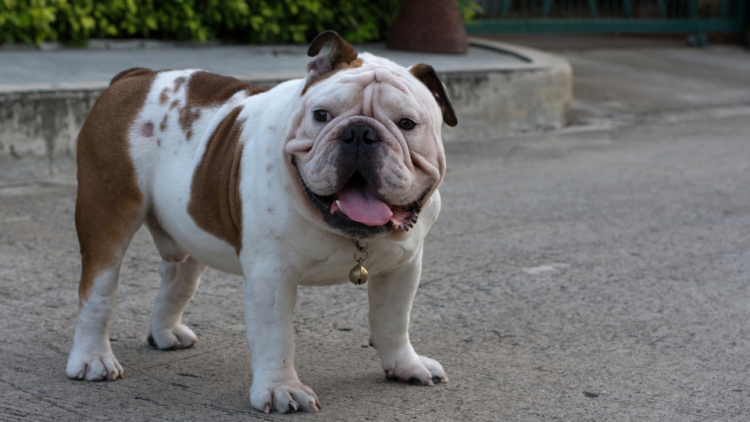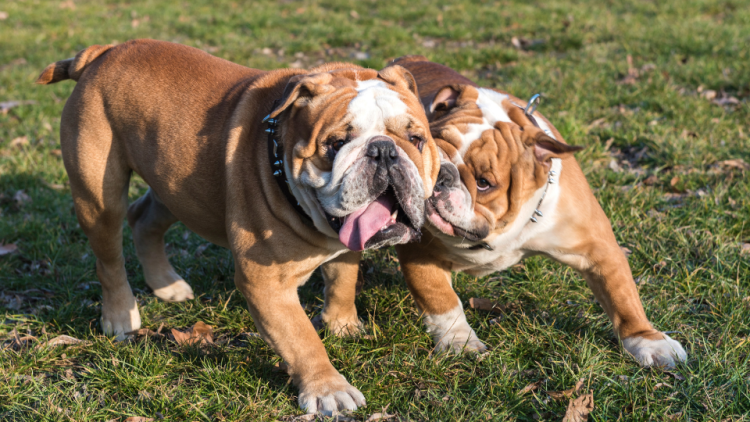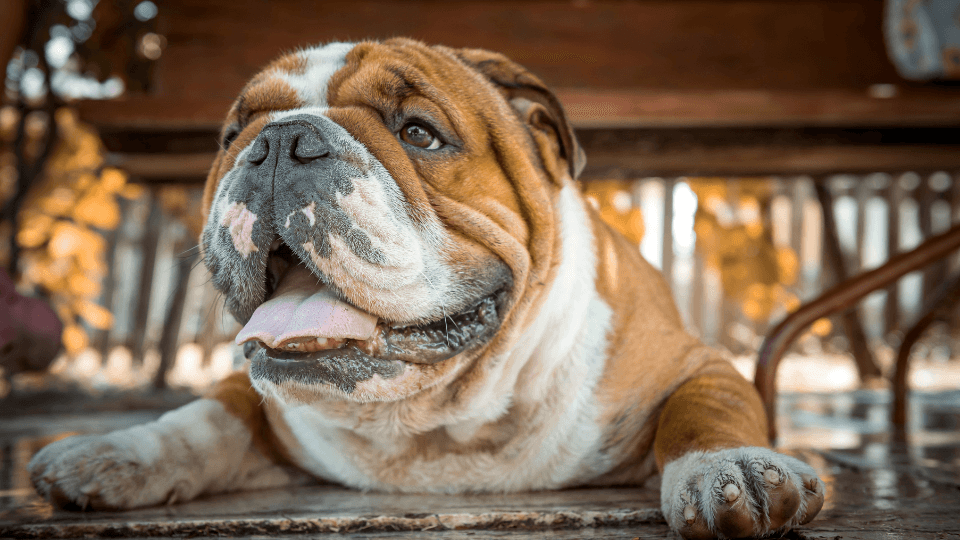Adored for their short stature, squishy faces, and sweet personalities, English Bulldogs are the 5th most popular breed in the US and their popularity keeps growing. The English Bulldog temperance is dependable, predictable, and calm, but is this breed right for you?
Read on to learn about common characteristics of this breed, including physical traits, personality features, history, care requirements, and more.
Table of Contents
- English Bulldog characteristics
- Physical appearance
- Personality and behavior
- Lifespan
- English Bulldog history
- English Bulldog care
- Training
- Exercise
- Grooming
- Nutrition
- Living with them
- Common English Bulldog health issues
- Where to adopt or buy a Bulldog
- Key Takeaways
Pro Tip: Deciding on the right pet insurance company is very important for you and your English Bulldog. Compare English Bulldog health insurance plans now and get reimbursed for up to 90% of your pet’s veterinary bills whenever they are sick or injured.
English Bulldog characteristics
Physical appearance
English Bulldog pictures quickly reveal a distinctive look. They have small, thin ears located at the back of the head, as well as deep folds of loose skin that start on the forehead and extend down to the jowl. Their anatomy is classified as brachycephalic, with eyes set wide above a short muzzle that features a broad, black nose, hanging upper lips, and a strongly undershot lower jaw.
Bulldogs are characterized by their large heads and broad shoulders. Given their short, sturdy, and wide-set legs, they tend to move quite slow. The average English Bulldog weight is between 40 and 50 pounds. Classified as medium-sized dogs, they stand between 12 and 16 inches tall at the shoulders.
This breed has a short, smooth coat that comes in a variety of colors, including white, fawn, red, and brindle. Some of their distinctive accents include white markings, piebald markings, and black masks.

Personality and behavior
The English Bulldog temperament is known to be gentle, sweet, dependable, and relatively predictable. They’re also known to be good with kids and enjoy human attention, which makes them great family dogs.
On the other hand, they were originally bred for bull-baiting, which means they are quite courageous and also make excellent watchdogs. In general, Bulldogs get along well with other pets but can be aggressive to dogs they don’t know without proper training and socialization.
Lifespan
The typical English Bulldog life expectancy is six to eight years old, but there are many factors that can influence their lifespan, including diet, exercise, and genetics. Size is also a factor; generally, small breed dogs tend to live longer than large breed dogs. Although English Bulldogs fall into the category of medium-sized dogs, they have several genetically heritable health conditions that contribute to their shorter lifespan than dogs of comparable size.
English Bulldog history
Originally bred in England as a cross between the Mastiff and the Pug, the main purpose of Bulldogs was to participate in a sport called bull-baiting, which was popular during the Middle Ages. The Bulldog’s mission was to attack and bite the bull, not releasing it from its grip until the bull was brought down. The dog was expected to fight to the end even when suffering pain.
After bull baiting was banned in the 1830s, the Bulldog’s popularity decreased and was almost extinct. However, devoted breeders refined the breed, selectively breeding to replace its original ferociousness with a more gentle disposition. Bulldogs were brought to the US in 1880 and the American Kennel Club (AKC) recognized the breed ten years later.
English Bulldog care
Training
As with all dog breeds, early socialization and puppy training classes are highly recommended in order to curb any undesirable behaviors and help your Bulldog grow into a well-adjusted adult dog.
Establishing a consistent routine including feeding schedule, outdoor time, and training routine will help your Bulldog to learn quickly what is expected of them in your home. This will make the rest of the training much easier.
Exercise
English Bulldogs aren’t very active but they do like daily outings and walks. Moderate exercise is a great way to keep your dog fit and healthy. They might enjoy chasing a ball for a few throws or wrestle with a toy but running is difficult for them.
Bulldogs also have trouble with stairs and should never be allowed in water that is more than elbow deep without supervision and a life jacket.
Due to the fact that their short muzzles make breathing difficult, avoid taking your Bulldog out during hot weather. When the temperature is over approximately 75 degrees Fahrenheit, limit your bulldog’s walks to short outings in the early morning and evening to avoid the heat of the day.
Provide them with access to cool, air-conditioned space so that they can breathe comfortably regardless of the heat outside. You may want to discuss the signs of heatstroke with your veterinarian so you know what to look for in the event your Bulldog gets too hot and needs medical attention.

Grooming
In general, the Bulldog is an average shedder and its short coat requires little grooming - a soft brush two to three times a week should be enough.
The wrinkles on the face should be checked regularly to ensure that the skin is dry and clean, as moisture and food can get trapped and cause skin infections or irritations. Their skin folds can generally be kept clean with regular wiping as needed with a moist wipe or clean cloth. The ears and the area under the tail should also be kept clean, and the nails need to be trimmed regularly.
Nutrition
Bulldogs love to eat, which puts them at risk of becoming overweight. Work with your vet to determine the amount of food your dog should be consuming daily, monitor their calorie intake closely, avoid feeding table scraps or extra treats, and feed only measured meals at scheduled times.
Treats should also be given sparingly and mainly as training rewards but should not make up more than 10% of your dog’s daily caloric intake. Clean, fresh water should be available at all times.
Many Bulldogs exhibit extreme possessiveness of their food (resource guarding), which can be quite serious if not controlled. Talk to your vet or professional dog trainer about how you can reduce or prevent this behavior in your pet. In addition, be sure not to let other people, especially children, or other pets approach your Bulldog while they are eating.
Living with them
Being low-endurance dogs, Bulldogs make fine indoor pets and don’t require a yard, which makes them great for city dwellers. They thrive best in temperate climates as high temperatures cause them to overheat and have breathing difficulties. They are also sensitive to cold weather because of their short snouts.
Bulldogs may not be the most suitable companions for people who wish to have their dog keep up with an active lifestyle. If you’re single, retired, or have a young family, these dogs might be a perfect choice, as long as you have time to spend relaxing at home with them.
Bulldogs aren’t known to be barkers, but they can make lots of noises, especially when they’re sleeping. Because of the short muzzle, these dogs are known for having breathing difficulties, which will make them snort, wheeze, and snore. Many members of this breed also drool.
Bulldogs also love to chew, so be sure to have lots of durable toys and ropes available. While training, be sure to teach your dog what’s acceptable to chew on and what’s not.
Common English Bulldog health issues
Bulldogs belong to the brachycephalic breed class, which means that they have a short head and snout. This physical characteristic can lead to a number of possible health issues, including problems related to the respiratory system, eyes, nose, and teeth.
Heat is a special concern with this breed since Bulldogs aren’t able to cool themselves efficiently through panting. Heatstroke is also more common compared to other breeds.
Due to the unusual airways, the breed also tends to suffer from complications while under anesthesia. Some of the most common health issues affecting English Bulldogs include:
- Hip dysplasia (a hip deformity that can occur before birth or during growth)
- Shoulder luxation (when the shoulder bone is displaced or completely removed from the joint socket1)
- Ventricular septal defect
- Keratoconjunctivitis sicca (KCS or dry eye)
- Stenotic nares (part of the brachycephalic syndrome, malformed nostrils that are narrow or collapse inward during inhalation)
- Internalized tail (a heritable abnormality where fused tail causes excessive skin folds, an immobile tail, and/or anal obstruction)
- Elongated soft palate (a soft palate that is too long for the length of the mouth).

Other, health issues in this breed include:
- Elbow dysplasia (a complex elbow joint that suffers from a structural defect)
- Distichiasis (a condition where hairs grow in an unusual area on the eyelid)
- Patellar luxation (occurs when the dog patella (kneecap) shifts out of alignment)
- Ectropion (an abnormality affecting the eyelids in which the lower eyelid 'rolls' outward or is everted)
- Entropion (an eye condition that causes the eyelids to roll inward)
- Cherry eye (a disorder affecting the nictitating membrane (NM), known as the third eyelid)
- Demodicosis (caused by Demodex canis, a parasitic mite that lives in the hair follicles of dogs)
- Urethral prolapse (when a small part of the urethra, or the tip, comes out from the opening of the dog’s penis) or vaginal hyperplasia (proliferation of the vaginal mucosa).
Due to the construction of their body, pregnant Bulldogs commonly require a Caesarean delivery for giving birth to puppies.
The facial and other body wrinkles need to be kept clean and dry in order to help prevent skin fold dermatitis and other skin issues.
Reputable breeders screen their genetic stock for conditions that can affect the breed and maintain the highest breed standards established by kennel clubs like the American Kennel Club. Pups bred by these standards are less likely to inherit some medical conditions, while others, such as Brachycephalic Airway Syndrome, affect almost all bulldogs because the breed standard reinforces a preference for Bulldogs with shorter muzzles.
Pro Tip: The average cost to diagnose and treat common English Bulldog health issues ranges between $300 and $7,500. Insuring your English Bulldog means that up to 90% of these costs will be covered. Without pet insurance, you’ll be responsible for covering the entire bill and payment is usually due before treatment is provided.
Where to adopt or buy a Bulldog
The fact that Bulldogs deliver puppies via Caesarean sections makes Bulldog puppies quite pricey. Many adult Bulldogs are available for adoption through various adoption and rescue groups. If you’re thinking about adopting a Bulldog, start by contacting the Bulldog Club of America.
Before you decide to adopt or buy a bulldog make sure to do plenty of research. If you’re interested in similar breeds, consider looking into Pugs, American Bulldogs, and Bull Terriers.
Key Takeaways
- English Bulldogs are known for their medium stature, distinct muscular appearance, as well as their relaxed and easy-going temperament, which makes them excellent family pets.
- Bulldogs can have short bursts of energy, but in general, they enjoy relaxing on the couch in a nice cool home.
- Originally bred for bull-baiting, Bulldogs are also courageous and loyal and will protect their family no matter what.
- Like all purebred dogs, Bulldogs are prone to certain diseases and conditions, including hip dysplasia and shoulder luxation.
- Before you decide to buy or adopt an English Bulldog, make sure to do plenty of research. Talk to rescue groups, other Bulldog owners, and reputable Bulldog breeders to learn more.
